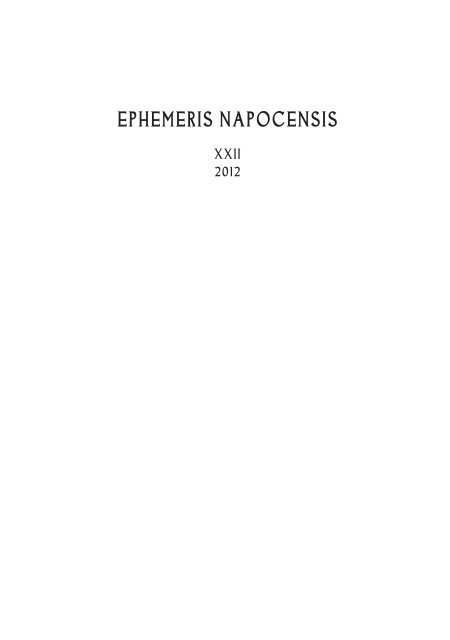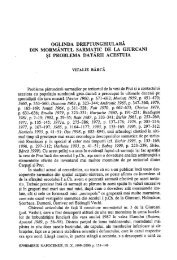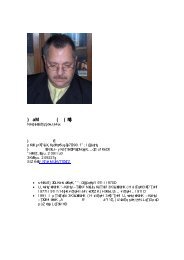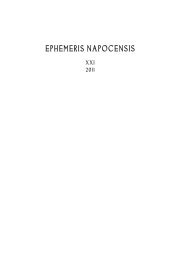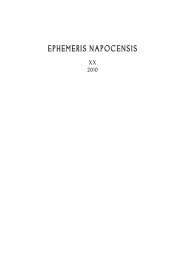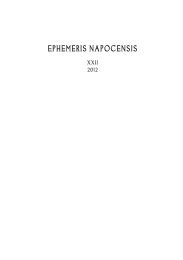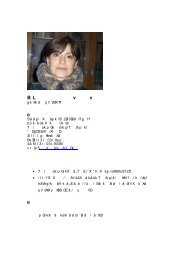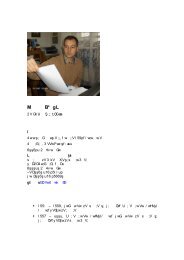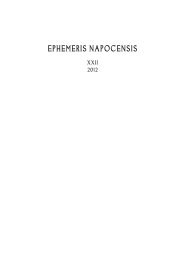EPHEMERIS NAPOCENSIS - Institutul de Arheologie Åi Istoria Artei
EPHEMERIS NAPOCENSIS - Institutul de Arheologie Åi Istoria Artei
EPHEMERIS NAPOCENSIS - Institutul de Arheologie Åi Istoria Artei
Create successful ePaper yourself
Turn your PDF publications into a flip-book with our unique Google optimized e-Paper software.
<strong>EPHEMERIS</strong> <strong>NAPOCENSIS</strong><br />
XXII<br />
2012
ROMANIAN ACADEMY<br />
INSTITUTE OF ARCHAEOLOGY AND HISTORY OF ART CLUJ-NAPOCA<br />
EDITORIAL BOARD<br />
Editor: Coriolan Horaţiu Opreanu<br />
Members: Sorin Cociş, Vlad-Andrei Lăzărescu, Ioan Stanciu<br />
ADVISORY BOARD<br />
Alexandru Avram (Le Mans, France); Mihai Bărbulescu (Rome, Italy); Alexan<strong>de</strong>r Bursche (Warsaw,<br />
Poland); Falko Daim (Mainz, Germany); Andreas Lippert (Vienna, Austria); Bernd Päffgen (Munich,<br />
Germany); Marius Porumb (Cluj-Napoca, Romania); Alexan<strong>de</strong>r Rubel (Iași, Romania); Peter Scherrer<br />
(Graz, Austria); Alexandru Vulpe (Bucharest, Romania).<br />
Responsible of the volume: Ioan Stanciu<br />
În ţară revista se poate procura prin poştă, pe bază <strong>de</strong> abonament la: EDITURA ACADEMIEI<br />
ROMÂNE, Calea 13 Septembrie nr. 13, sector 5, P. O. Box 5–42, Bucureşti, România, RO–76117,<br />
Tel. 021–411.90.08, 021–410.32.00; fax. 021–410.39.83; RODIPET SA, Piaţa Presei Libere nr. 1,<br />
Sector 1, P. O. Box 33–57, Fax 021–222.64.07. Tel. 021–618.51.03, 021–222.41.26, Bucureşti,<br />
România; ORION PRESS IMPEX 2000, P. O. Box 77–19, Bucureşti 3 – România, Tel. 021–301.87.86,<br />
021–335.02.96.<br />
<strong>EPHEMERIS</strong> <strong>NAPOCENSIS</strong><br />
Any correspon<strong>de</strong>nce will be sent to the editor:<br />
INSTITUTUL DE ARHEOLOGIE ŞI ISTORIA ARTEI<br />
Str. M. Kogălniceanu nr. 12–14, 400084 Cluj‐Napoca, RO<br />
e-mail: choprean@yahoo.com<br />
All responsability for the content, interpretations and opinions<br />
expressed in the volume belongs exclusively to the authors.<br />
DTP and print: MEGA PRINT<br />
Cover: Roxana Sfârlea<br />
© 2012 EDITURA ACADEMIEI ROMÂNE<br />
Calea 13 Septembrie nr. 13, Sector 5, Bucureşti 76117<br />
Telefon 021–410.38.46; 021–410.32.00/2107, 2119
ACADEMIA ROMÂNĂ<br />
INSTITUTUL DE ARHEOLOGIE ŞI ISTORIA ARTEI<br />
<strong>EPHEMERIS</strong><br />
<strong>NAPOCENSIS</strong><br />
XXII<br />
2012<br />
EDITURA ACADEMIEI ROMÂNE
SOMMAIRE – CONTENTS – INHALT<br />
STUDIES<br />
FLORIN GOGÂLTAN<br />
Ritual Aspects of the Bronze Age Tell-Settlements in the Carpathian Basin.<br />
A Methodological Approach .............................................7<br />
ALEXANDRA GĂVAN<br />
Metallurgy and Bronze Age Tell-Settlements from Western Romania (I) ............57<br />
DÁVID PETRUŢ<br />
Everyday Life in the Research Concerning the Roman Army in the Western European<br />
Part of the Empire and the Province of Dacia .................................91<br />
CORIOLAN HORAŢIU OPREANU<br />
From “στρατόπεδον” to Colonia Dacica Sarmizegetusa. A File of the Problem ........113<br />
CĂLIN COSMA<br />
Ethnische und politische Gegebenheiten im Westen und Nordwesten Rumäniens<br />
im 8.–10. Jh. n.Chr. ...................................................137<br />
ARCHAEOLOGICAL AND EPIGRAPHICAL NOTES<br />
AUREL RUSTOIU<br />
Commentaria Archaeologica et Historica (I) .................................159<br />
VITALIE BÂRCĂ<br />
Some Remarks on Metal Cups with Zoomorphic Handles<br />
in the Sarmatian Environment ............................................185<br />
FLORIN FODOREAN<br />
“Spa” Vignettes in Tabula Peutingeriana. Travelling Ad Aquas: thermal Water Resources<br />
in Roman Dacia .......................................................211<br />
DAN AUGUSTIN DEAC<br />
Note on Apis Bull Representations in Roman Dacia ...........................223<br />
SILVIA MUSTAŢĂ, SORIN COCIŞ, VALENTIN VOIŞIAN<br />
Instrumentum Balnei from Roman Napoca. Two Iron Vessels Discovered on the Site<br />
from Victor Deleu Street ................................................235<br />
IOAN STANCIU<br />
About the Use of the So-Called Clay “Breadcakes” in the Milieu of the Early Slav<br />
Settlements (6 th –7 th Centuries) ............................................253
DAN BĂCUEŢ-CRIŞAN<br />
Contributions to the Study of Elites and Power Centers in Transylvania during the second<br />
Half of the 9 th – first Half of the 10 th Centuries. Proposal of I<strong>de</strong>ntification Criteria Based<br />
on archaeological Discoveries .............................................279<br />
ADRIANA ISAC, ERWIN GÁLL, SZILÁRD GÁL<br />
A 12 th Century Cemetery Fragment from Gilău (Cluj County) (Germ.: Julmarkt;<br />
Hung.: Gyalu) ........................................................301<br />
ADRIAN ANDREI RUSU<br />
Stove Tiles with the Royal Coat of Arms of King Matthias I Corvinus ..............313<br />
REVIEWS<br />
IULIAN MOGA, Culte solare şi lunare în Asia Mică în timpul Principatului/Solar and Lunar Cults in<br />
Asia Minor in the Age of the Principate, Editura Universităţii “Alexandru Ioan Cuza” Iaşi (Iaşi<br />
2011), 752 p. (Szabó Csaba) .............................................327<br />
DAN GH. TEODOR, Un centru meşteşugăresc din evul mediu timpuriu. Cercetările arheologice <strong>de</strong> la<br />
Lozna-Botoşani/An Artisan centre from the Early Middle Ages. The archaeological research from<br />
Lozna-Botoşani, Bibliotheca Archaeologica Moldaviae XV, Aca<strong>de</strong>mia Română – Filiala Iaşi,<br />
<strong>Institutul</strong> <strong>de</strong> <strong>Arheologie</strong>, Editura Istros (Brăila 2011), 200 p. (including 118 figures), abstract<br />
and list of figures in French (Ioan Stanciu) ...................................331<br />
CĂLIN COSMA, Funerary Pottery in Transylvania of the 7 th –10 th Centuries, Series Ethnic and<br />
Cultural Interferences in the 1 st Millenium B.C. to the 1 st Millenium AD. 18, Romanian<br />
Aca<strong>de</strong>my – Institute of Archaeology and Art History Cluj‐Napoca, Mega Publishing House<br />
(Cluj-Napoca 2011), 183 p., 49 plates (Aurel Dragotă) .........................339<br />
RESEARCH PROJECTS<br />
Crossing the Boundaries. Remo<strong>de</strong>ling Cultural I<strong>de</strong>ntities at the End of Antiquity in Central and Eastern<br />
Europe. A Case Study (Coriolan H. Oprean, Vlad-Andrei Lăzărescu) ...............343<br />
Warriors and military retainers in Transylvania of the 7 th –9 th centuries (Călin Cosma) .........349<br />
Seeing the Unseen. Landscape Archaeology on the Northern Frontier of the Roman Empire at Porolissvm<br />
(Romania) (Coriolan H. Oprean, Vlad-Andrei Lăzărescu) .......................352<br />
Abbreviations that can not be found in Bericht <strong>de</strong>r Römisch-Germanische Kommission .....363<br />
Gui<strong>de</strong>lines for “Ephemeris Napocensis” .........................................366
Silvia Mustaţă, Sorin Cociş, Valentin Voişian<br />
INSTRUMENTUM BALNEI FROM ROMAN NAPOCA.<br />
TWO IRON VESSELS DISCOVERED ON THE SITE<br />
FROM VICTOR DELEU STREET *<br />
Silvia Mustaţă 1 , Sorin Cociş 2 , Valentin Voişian 3<br />
Abstract: The two iron toilette vessels analysed in this article were discovered in Cluj‐Napoca during<br />
the rescue excavations carried out on Victor Deleu Street between 1992 and 2001. Both of them correspond<br />
from a stratigraphic viewpoint to the second stone phase of the two buildings researched on the site<br />
which belonged to the resi<strong>de</strong>ntial area of the Roman town. Taking into account the context of discovery,<br />
they were <strong>de</strong>finitely in use in Napoca during the first three quarters of the 3 rd century AD. Due to<br />
the rarity of such objects at the scale of the Roman Empire, the analysis focuses on the technical aspects<br />
that the manufacturing process of such items implies (employing X-ray photography), on the parallels<br />
from the rest of the Roman world and on the possible prototypes which might have influenced the <strong>de</strong>velopment<br />
of such shapes in iron.<br />
Keywords: Napoca, iron vessels, instrumentum balnei, technology, prototypes<br />
During archaeological research carried out in Cluj‐Napoca, Victor Deleu Street, two<br />
iron vessels were discovered which will be the subject of the present article. The vessels are<br />
unique in Roman Dacia and represent remarkable finds at the level of the Roman Empire.<br />
The analysis will focus on the technical aspects that the objects imply as well as on parallels and<br />
possible prototypes.<br />
The site<br />
The archaeological rescue excavations un<strong>de</strong>rtaken more or less continuously in Cluj‐Napoca,<br />
Victor Deleu Street (Pl. I/1) between the years 1992 and 2001 revealed important information<br />
about the evolution of the ancient town of Napoca 4 . Besi<strong>de</strong>s the medieval and mo<strong>de</strong>rn habitation<br />
*<br />
A preliminary version of this paper was published in Instrumentum. Bulletin du Groupe <strong>de</strong> travail européen sur<br />
l’artisanat et les productions manufacturées dans l’Antiquité (see: MUSTAȚĂ ET ALII 2012). The authors would like<br />
to express their gratitu<strong>de</strong> towards dr. Cosmin Onofrei and resi<strong>de</strong>nt Dan Duma for their help in X-raying the objects<br />
and towards dr. Mariana Egri and Szilamér Péter Pánczél for the useful discussions referring to the prototypes.<br />
1<br />
“Babeş-Bolyai” University, Cluj‐Napoca, RO; e-mail: silvia_mustata@yahoo.com.<br />
2<br />
Institute of Archaeology and Art History Cluj‐Napoca, Romanian Aca<strong>de</strong>my Cluj Branch, M. Kogălniceanu<br />
str. 12–14, 400084, Cluj‐Napoca, Cluj county, RO; e-mail: scocis@yahoo.com.<br />
3<br />
National Museum of Transylvanian History, Constantin Daicoviciu str. 2, 400020, Cluj‐Napoca, RO;<br />
e-mail: vvoisian@yahoo.com.<br />
4<br />
For the preliminary excavation reports see: COCIŞ ET AL. 1995; COCIŞ ET AL. 1996; COCIŞ ET AL.<br />
1997; COCIŞ ET AL. 1998; COCIŞ ET AL. 1999; COCIŞ ET AL. 2002. See also: RUSU-BOLINDEŢ 2007,<br />
97–98; GĂZDAC ET AL. 2010, 7–8.<br />
Ephemeris Napocensis, XXII, 2012, p. 235–251
236 Silvia Mustaţă, Sorin Cociş, Valentin Voişian<br />
(11 th –12 th , 14 th –15 th and 17 th –18 th centuries), parts of a resi<strong>de</strong>ntial area of the Roman town were<br />
unearthed. The stratigraphy of the Roman period shows a continuous inhabitation of the site<br />
from the time of Trajan till the abandonment of the province. Three timber and two stone phases<br />
were i<strong>de</strong>ntified, corresponding to the following activities: the establishment of the first colonist<br />
groups coming, based on the archaeological material, from Noricum and Pannonia (1 st timber<br />
phase: Trajan), timber structures – the vicus phase (2 nd timber phase: Trajan–Hadrian), two aligned<br />
timber buildings proving the existence of a street pattern – the municipal phase (3 rd timber phase:<br />
Hadrian–Antoninus Pius), the construction of two stone houses, named conventionally C1 and<br />
C2 (1 st stone phase: middle of the 2 nd century–Septimius Severus) and the partial renewal of the<br />
buildings (2 nd stone phase: Septimius Severus–the abandonment of the province) 5 . Each stone<br />
phase was once repaired during its existence and for the 2 nd phase of building C2 6 this moment<br />
can be very well placed in time: in room b two floors were i<strong>de</strong>ntified, divi<strong>de</strong>d by a <strong>de</strong>struction<br />
layer containing a lot of burning traces. The first floor was broken and a monetary hoard, namely<br />
a pottery vessel with lid, filled with 1268 silver <strong>de</strong>narii ending at Severus Alexan<strong>de</strong>r, was hid<strong>de</strong>n<br />
un<strong>de</strong>r it 7 . On the new floor, built on top of the <strong>de</strong>struction layer, two coins from Philippus Arabs<br />
were discovered 8 . It has been suggested that the hiding of the monetary hoard and the <strong>de</strong>structions<br />
suffered by this part of the Roman town could be framed in a general phenomenon which affected<br />
Roman Napoca in the 3 rd century AD, namely the conflicts between emperor Maximinus Thrax<br />
and barbarians from the north 9 , theory which will have to be confirmed in the future by new field<br />
research insi<strong>de</strong> the ancient town 10 .<br />
Even if most of the information regarding the site is still forthcoming, important<br />
categories of archaeological material have already been analysed in separate studies: the<br />
brooches 11 , the coins 12 , a votive altar 13 , the pottery 14 , the above mentioned monetary hoard<br />
as well as the finds belonging to the early medieval period 15 .<br />
The vessels<br />
The first vessel (Pl. III/1, V/1, 2a–c) (National History Museum of Transylvania,<br />
Cluj‐Napoca, without inventory no. ) was i<strong>de</strong>ntified in house C1, in the western profile, in a<br />
layer related to the last occupation sub phase belonging to the 2 nd stone phase of the building<br />
(Pl. II), dated roughly from the middle of the 3 rd century to the time of the abandonment of<br />
the province 16 . The object, flask-shaped with a narrow neck and a strongly arched spherical<br />
body, is partially preserved: part of the fastening system of the lid is missing as well as part<br />
of the base and the two small handles which should have been, theoretically, attached un<strong>de</strong>r<br />
the rim. It has the following dimensions: H: 92.7 mm; maximum body D: 89.2 mm; rim<br />
D: 30.3: base D; 56.9 mm and it weighs 249 g. The manufacture material is iron with the<br />
5<br />
COCIŞ ET AL. 1995; RUSU-BOLINDEŢ 2007, 98; OPREANU 2009, 393.<br />
6<br />
The construction works from Deleu Street began in 1991 without a proper archaeological survey and an<br />
important part of the upper Roman layers, especially in the area of building C1, were <strong>de</strong>stroyed. For this reason only<br />
in the case of building C2 it was possible to collect more <strong>de</strong>tailed stratigraphic data (See: COCIŞ ET AL. 1995, 637).<br />
7<br />
For the monographic publication of the hoard see: GĂZDAC ET AL. 2010.<br />
8<br />
COCIŞ ET AL. 1995, 638.<br />
9<br />
OPREANU 2009, 134.<br />
10<br />
See GĂZDAC ET AL. 2010, 15.<br />
11<br />
COCIŞ ET AL. 2001.<br />
12<br />
GĂZDAC ET AL. 2003.<br />
13<br />
COCIŞ ET AL. 2004.<br />
14<br />
RUSU-BOLINDEŢ 2007.<br />
15<br />
ŢIPLIC ET AL. 2004.<br />
16<br />
COCIŞ ET AL. 1995, 637–639.
Instrumentum Balnei from Roman Napoca<br />
237<br />
exception of a bronze plate which was set into the rim (Pl. V/1). The bronze plate, representing<br />
the fixed part of the closing system, displays two holes: an oval one positioned near<br />
the rim (D: 9.4–10.7 mm) which allowed the liquid to exit and a small, circular central one<br />
(D: 2.6 mm) which was used for fastening another mobile metal plate (lost today). This in<br />
turn, provi<strong>de</strong>d with two small knobs, displayed a similar opening as the above mentioned oval<br />
one and sealed its counterpart from the set plate by rotation. The vessel was recovered from<br />
the excavation in a bad state of preservation (strongly oxidized, <strong>de</strong>formed body, base broken<br />
from the body and fragmented in three parts) (Pl. 1/2). For this reason during the restoration<br />
process, in or<strong>de</strong>r to ensure its stability, it was covered in some parts with a thick layer of<br />
resin, process which <strong>de</strong>termined important changes from the original shape, especially in the<br />
area of the rim and of the base. In this situation, in or<strong>de</strong>r to reconstruct the original shape<br />
of the vessel as accurately as possible, the technique of X-ray photography was employed<br />
(Pl. IV/1–2). It can be observed very well that the exterior part of the rim was not straight,<br />
but slightly reverted and that the original base had a smaller diameter than the one obtained<br />
after restoration and it was less flared (Pl. IV/2). The X-ray offers also important <strong>de</strong>tails about<br />
the technology employed in the manufacturing process of the vessel: the body was ma<strong>de</strong> from<br />
two hemispherical parts joined in the point of the maximum diameter. The two joining lines<br />
visible in the area of the rim show that this part was worked separately and subsequently<br />
attached to the body; the rim, at its turn, was ma<strong>de</strong> out of two pieces of metal separated by<br />
the bronze plate. It is not certain whether the base was also separately ma<strong>de</strong> or it was part of<br />
the lower hemisphere. Taking into account that it was found broken and reattached during<br />
restoration, this remains for the moment an open question.<br />
The second vessel (Pl. VI/1, VIII/1a–d, IX/1a–d, 2, 3) (National History Museum<br />
of Transylvania, Cluj‐Napoca, without inventory no.) was i<strong>de</strong>ntified in room b, consi<strong>de</strong>red<br />
to be an annex 17 belonging to the 2 nd phase of house C2 (Pl. II). The vessel was found on<br />
the first floor near the place where the monetary hoard was hid<strong>de</strong>n, together with a group of<br />
metal objects: two bronze vessels (a jug of Millingen type and a handle from a Blechkanne),<br />
two bronze candlesticks, a bronze statuette <strong>de</strong>picting a ram and several pieces of bronze sheet<br />
with figural <strong>de</strong>coration 18 . It is not clear whether the objects were intentionally collected and<br />
hid<strong>de</strong>n or they were kept in a woo<strong>de</strong>n chest or cupboard which was abandoned in a time of<br />
danger. Thus, relying on the stratigraphic data, it can be asserted that the vessel was certainly<br />
in use in the first half of the 3 rd century AD. The object ma<strong>de</strong> entirely of iron, was discovered<br />
in a fragmentary state (Pl. IX/2–3), one of the handles was missing and it was reconstructed<br />
during restoration. It presents a vertical rim, a narrow neck and a spherical body. It does not<br />
have a base and the lower part of the body is slightly elongated, ending in a small protuberance.<br />
The original handle, attached below the rim and ending with a leaf shaped appliqué,<br />
still preserves half of a loop which was part of the hanging chain. It displays the following<br />
dimensions: H: 100 mm; maximum body D: 82.8 mm; rim D: 38.9–41.6 mm and it weighs<br />
259 g. The lid seems to present a similar system to the one <strong>de</strong>scribed above: an upper mobile<br />
plate presenting two knobs and a lower, fixed one. Since the vessel was restored it is not<br />
possible anymore to observe the two oval openings that the plates should have had. Still,<br />
based on the information offered by the X-ray (Pl. VII/1–2) it looks like the whole lid system<br />
was worked separately and afterwards fitted insi<strong>de</strong> the rim. Even if not very clear, the X-ray<br />
seems to show a shallow line which could mark the limit between the plates. Concerning the<br />
manufacturing process, besi<strong>de</strong>s the handles and the lid, the body of the vessel was ma<strong>de</strong> from<br />
two different parts, an upper one together with the rim and a lower one, which are joined<br />
above the line of the maximum diameter.<br />
17<br />
OPREANU 2008, 393.<br />
18<br />
COCIŞ ET AL. 1995, 637–638.
238 Silvia Mustaţă, Sorin Cociş, Valentin Voişian<br />
Discussion<br />
Despite the common character of the raw material, iron vessels represent exceptional<br />
finds on Roman period sites. This situation was explained in the literature through the nature<br />
of iron, much more exposed to oxidation in comparison with other metals, fact which <strong>de</strong>termined<br />
the preservation of a smaller number of objects, but also through the lack of interest<br />
shown by the specialists for this kind of finds 19 . To this, one may add the technical difficulties<br />
that the craftsman might have encountered when trying to forge iron in or<strong>de</strong>r to manufacture<br />
objects of such small dimensions, since it was not possible to cast it.<br />
There can be distinguished three main categories of Roman iron vessels, ma<strong>de</strong> totally<br />
of iron or combining iron with parts ma<strong>de</strong> of cooper alloys, dated generally between the 2 nd and 4 th<br />
centuries AD. The most numerous group, from the viewpoint of the number of finds, is composed<br />
of iron water jugs 20 . Such vessels were discovered mainly in the Western provinces of the Empire 21<br />
and on the territory of Roman Pannonia 22 . Another category is represented by the iron flasks or<br />
so-called “pilgrim flasks” 23 . The finds belonging to this group are rare. One can mention here<br />
a vessel, ma<strong>de</strong> from two iron halves covered in the superior part with bronze straps, found in<br />
a well, dated to the Antonine period, from the Roman fort at Newstead, Roman Britain 24 and<br />
the iron flask from the <strong>de</strong>posit found in the well from the Roman fort at Rainau Buch (Rainau,<br />
Ba<strong>de</strong>n-Württemberg, Germany) 25 . Another such object was discovered in a 2 nd century grave<br />
from the southern necropolis at Abritvs (Hisarlâk, near Razgrad, Bulgaria). The vessel presents<br />
two appliqués attached on the shoul<strong>de</strong>r which allowed the fastening of the preserved handle 26 .<br />
The Archaeological Museum from Vienne (Rhône-Alpes, France) preserves in its collections a<br />
flask ma<strong>de</strong> of iron, as part of the Gréan Collection, presenting a bronze neck and rim and having<br />
the body partially wrapped by a bronze “belt” 27 . Probably the most interesting example from this<br />
category is represented by a flask discovered in the 19 th century in the river Saône: the vessel, ma<strong>de</strong><br />
also from two iron halves covered by a bronze strap, was inlayed on each si<strong>de</strong> with brass and pure<br />
cooper, forming a <strong>de</strong>licate <strong>de</strong>coration <strong>de</strong>picting a wine leaf with a bunch of grapes 28 .<br />
The third category of Roman iron vessels, in which the two objects from Napoca can<br />
also be inclu<strong>de</strong>d, consists of toilette vessels. Typologically, this kind of vessels can be divi<strong>de</strong>d into<br />
two main types: globular and flask-shaped vessels. Among the globular ones, probably the most<br />
representative is a vessel found also in the river Saône, displaying a globular iron body, two bronze<br />
19<br />
BARATTE 1993, 224.<br />
20<br />
Taking into account the morphology, the Roman iron water jugs represent, up to a certain extent, a version<br />
of the provincial type of bronze Belchkannen, very popular during the 2 nd and 3 rd centuries AD and used for boiling<br />
the water. This functionality is confirmed by the traces of scale discovered insi<strong>de</strong> both iron and bronze objects<br />
(BARATTE 1993, 227; KOSTER 1997, 30 with further bibliography; for the typology of the bronze Blechkannen<br />
see: BOLLA 1979 and BOLLA 1989 with further bibliography).<br />
21<br />
BARATTE 1993, 224–227; KOSTER 1997, 30–41.<br />
22<br />
SZIRMAI 1993: the author analyzes only the funerary finds coming from the Late Roman cemeteries dated<br />
between the second half of the 3 rd century and the second half of the 4 th century AD.<br />
23<br />
For an overview of the main discoveries see: FEUGÈRE 1991, 125–126; KAUFMANN-HEINIMANN<br />
1994, 172–174.<br />
24<br />
CLOSE-BROOKS 1980.<br />
25<br />
PLANCK 1983, 330–331, Abb. 131.<br />
26<br />
IVANOV/STOJANOV 1985, 70, fig. 96: from the published photograph it is not clear the way the handle<br />
was attached to the two appliqués. One can presume that it was either discovered separately in the grave and,<br />
subsequently, attributed to the vessel or the vessel was repaired in Antiquity and a handle, belonging originally to a<br />
different type of vessel, was ad<strong>de</strong>d.<br />
27<br />
BOUCHER 1971, 138, no. 254.<br />
28<br />
BARATTE ET AL. 1984, 110 no. 174, Pl.: LIV/174; LXXIV/174 (see also no. 200: a similar iron flask<br />
having only the inferior part of the body preserved); BONNAMOUR 2000, 41, 127–128, no. 136.
Instrumentum Balnei from Roman Napoca<br />
239<br />
handle appliqués <strong>de</strong>corated with Bacchic masks and a bronze handle 29 . The Royal-Athena Galleries<br />
from New York preserve in their collection an exquisite piece belonging to this category: an iron<br />
globular vessel with bronze base, provi<strong>de</strong>d with two loop shaped appliqués which allowed the<br />
attachment of a massive bronze chain, completely preserved. The most interesting part of the vessel<br />
is represented by the bronze lid: a representation of Venus Anadyomene as a child riding a dolphin 30 .<br />
From the category of iron flask-shaped vessels, the one which resembles the most with the<br />
vessel with base from Napoca (Pl. III/1, V/1, 2a–c) comes from Rottenburg am Neckar (Ba<strong>de</strong>n-<br />
Württemberg, Germany), being generally dated between the 2 nd and the 3 rd century AD. The object<br />
presents the same strongly arched body and in the area of the maximum diameter the joining line<br />
of the two hemispheric parts is still visible. It has two small handles ma<strong>de</strong> of iron attached un<strong>de</strong>r<br />
the rim, each of them preserving the first loop of the bronze hanging chain. The rim is vertical and<br />
it was ma<strong>de</strong> out of bronze or brass 31 . Two other examples were i<strong>de</strong>ntified in funerary contexts from<br />
Pannonia Inferior. The first one was discovered in 1935 at Vajta (Fejér county, Hungary) associated<br />
with a strigilis, in a wagon-grave disturbed by mo<strong>de</strong>rn activities. This vessel shows a very strong<br />
resemblance with the second iron vessel from Napoca (Pl. VI/1, VIII/1a–d, IX/1a–d, 2, 3). It has<br />
a vertical rim covered with a plate of bronze, two small handles attached un<strong>de</strong>r the rim which both<br />
preserve the first loop of a bronze chain, a narrow neck and a spherical body en<strong>de</strong>d in the lower<br />
part with the same small protuberance 32 . The only difference from the vessel discovered at Napoca<br />
is represented by the presence of a ring-shaped base, but if one takes into consi<strong>de</strong>ration the fact<br />
that the lowest point of the body is arched and marked with a knob, it can not be exclu<strong>de</strong>d that<br />
initially the vessel did not have a base and that it was ad<strong>de</strong>d subsequently, during its usage period,<br />
in or<strong>de</strong>r to allow it to remain in a vertical position. The other iron vessel known from Pannonian<br />
contexts comes from the necropolis at Intercisa (Dunaújváros, Fejér county, Hungary), without the<br />
possibility of a closer dating. The object is flask-shaped, with a narrow neck and a reverted rim.<br />
The maximum diameter is located in this case in the lower part of the body 33 .<br />
Taking into account the rarity of such objects and the raw material they were ma<strong>de</strong> of, the<br />
question that arises related to the shape, is whether they represent original items or they imitate<br />
shapes which are common in other categories of material. The morphology presented by the first<br />
vessel from Napoca (Pl. III/1, V/1, 2a–c) can be easily traced, since it has the same characteristics<br />
as a certain type of copper alloy flask-shaped toilette vessel, ma<strong>de</strong>, usually, from two pieces of metal<br />
which are joined above the shoul<strong>de</strong>r, with globular body and narrow neck, typical for the Roman<br />
provinces during the 2 nd and 3 rd centuries AD 34 . An important characteristic of the type is the<br />
closing system of the lid, consisting of, as above mentioned, two plates of metal: a lower one set<br />
into the rim and a mobile upper one. Such system can be observed on some better preserved pieces<br />
like the one from Rainau-Buch 35 or the one from Calvatone (Lombardy, Italy) 36 .<br />
Concerning the second vessel (Pl. VI/1, VIII/1a–d, IX/1a–d, 2, 3), even if it displays<br />
the same lid mechanism, its shape does not show resemblance with other type of vessels ma<strong>de</strong><br />
of metal. At a first glance it can be noticed a similarity with glass toilette vessels belonging to<br />
the type Isings 61 37 , but there are some differences: in our case the rim is not flattened and<br />
29<br />
BARATTE ET AL. 1984, 128–129, no. 199, Pl.: LX/199; LXXVI/199; BONNAMOUR 2000, 41, 131 no. 204.<br />
30<br />
The vessel is offered for sale and can be accessed at the following internet address: http://www.royalathena.<br />
com/pages/RomanCatalog/Bronze/Vessels/GMZ15.html (10.03.2012).<br />
31<br />
SEITZ 2005, 362 Abb. 483.<br />
32<br />
FÜLEP 1949, 41–42, 28. tábla/1–3.<br />
33<br />
RADNÓTI 1957, 191, 218 no. 22, Pl. XXXIX/11; SZIRMAI 1993, 422, 427, Fig. 7/6.<br />
34<br />
SEDLMAYER 1999, 42, Taf. 16/11–14 with an overview of the finds and the bibliography; CASTOLDI<br />
2002, 300–303; BIENERT 2007, 232–233, 237–239, nos.: 271–273.<br />
35<br />
PLANCK 1983, 332 Abb. 134/1.<br />
36<br />
CASTOLDI 2002, 301, fig. 12, 303, fig. 16.<br />
37<br />
ISINGS 1957, 78–80.
240 Silvia Mustaţă, Sorin Cociş, Valentin Voişian<br />
the vessel cannot stay in a vertical position. On the other hand, one cannot help noticing<br />
the similarities, without any other functional implications, between the shape of this iron vessel<br />
and the one displayed by one of the most common olive oil amphorae, namely those belonging<br />
to the type Dressel 20 38 . The similarity is surprising since both the Dressel 20 amphorae and<br />
the iron vessel from Napoca were used for transporting oil, but in totally different contexts.<br />
In conclusion the two iron vessels from Napoca were <strong>de</strong>finitely in use during the first<br />
three quarters of the 3 rd century AD, as suggested by the contexts of discovery. As the parallels<br />
from the rest of the Roman Empire and the prototypes show, they were part of the instrumentum<br />
balnei and were employed for carrying the oil to the baths. There is no reason to presume a<br />
different functionality consi<strong>de</strong>ring the existence of the hanging chains and the fastening system<br />
of the lid which allowed a perfect sealing of the content.<br />
BIBLIOGRAPHY<br />
BARATTE 1993<br />
F. BARATTE, Obsevations complémentaires à propos <strong>de</strong> <strong>de</strong>ux objets en fer du trésor <strong>de</strong> Vienne.<br />
Arch. Korrbl. 23, 1993, 223–229.<br />
BARATTE ET ALII 1984<br />
F. BARATTE/L. BONAMOUR/J.-P. GUILLAUMET/S. TASSINARI, Vases antiques <strong>de</strong> metall<br />
au Musée <strong>de</strong> Chalon-sur-Saône. Rev. Arch. Est et Centre-Est suppl. 5 e (Dijon 1984).<br />
BIENERT 2007<br />
B. BIENERT, Die römischen Bronzegefäße im Rheinischen Lan<strong>de</strong>smuseum Trier [Trierer<br />
Zeitschr. 31] (Trier 2007).<br />
BOLLA 1979<br />
M. BOLLA, Recipienti in bronzo d’età romana in Lombardia. Brocca rinvenuta a Carobbio<br />
<strong>de</strong>gli Angeli. Riv. Arch. Prov. e Ant. Diocesi Como 161, 1979, 23–50, tavv. I–V.<br />
BOLLA 1989<br />
M. BOLLA, “Blechkannen”: aggiornamenti. Rassegna Stud. Civ. Mus. Arch. Milano 43–44,<br />
1989, 95–118, tavv. XLVI–LIX.<br />
BONNAMOUR 2000<br />
L. BONNAMOUR, Archéologie <strong>de</strong> la Saône. 150 ans <strong>de</strong> recherches. Le fleuve gardien <strong>de</strong> la<br />
mémoire (Paris 2000).<br />
BOUCHER 1971<br />
S. BOUCHER, Vienne. Bronzes antiques, Inventaire <strong>de</strong>s Collections Publiques Françaises 17<br />
(Paris 1971).<br />
CASTOLDI 2002<br />
M. CASTOLDI, I recipienti in bronzo in Italia Settentrionale tra III e V secolo d. C.<br />
In: G. Cuscito/M. Verzár-Bass (a cura di), Bronzi di età romana in Cisalpina. Novità e riletture,<br />
Antichità Altoadriatiche 51 (Trieste 2002), 289–308.<br />
CLOSE-BROOKS 1980<br />
J. CLOSE-BROOKS, A Roman iron flask from Newstead. Proc. Soc. Ant. Scotland 109, 1977–<br />
1978 [1980], 372–374.<br />
COCIŞ ET AL. 1995<br />
S. COCIŞ/V. VOIŞIAN/A. PAKI/M. ROTEA, Raport preliminar privind cercetările arheologice<br />
din strada Victor Deleu în Cluj‐Napoca I. Campaniile 1992–1994. Acta Mus. Napocensis 32/I,<br />
1995, 635–652.<br />
COCIŞ ET AL. 1996<br />
S. COCIŞ/A. PAKI/V. VOIŞIAN, Cluj‐Napoca, jud. Cluj. Strada Victor Deleu. In CCA.<br />
Campania 1995 (Brăila 1996), 35–36.<br />
38<br />
PEACOCK/WILLIAMS 1986, 136, class 25, Fig. 67.
Instrumentum Balnei from Roman Napoca<br />
241<br />
COCIŞ ET AL. 1997<br />
S. COCIŞ/V. VOIŞIAN/A. PAKI/ZS. MOLNÁR, Cluj‐Napoca, jud. Cluj. Str. V. Deleu.<br />
In: CCA. Campania 1996 (Bucureşti 1997), 14.<br />
COCIŞ ET AL. 1998<br />
S. COCIŞ/V. VOIŞIAN/A. PAKI, Cluj‐Napoca, str. V. Deleu. In: CCA. Campania 1997<br />
(Bucureşti 1998), 17.<br />
COCIŞ ET AL. 1999<br />
S. COCIŞ/ZS. MOLNÁR/A. PAKI/V. VOIŞIAN, Cluj‐Napoca, jud. Cluj. In: CCA. Campania<br />
1998 (Bucureşti 1999), 31.<br />
COCIŞ ET AL. 2001<br />
S. COCIŞ/C. CIONGRADI/V. VOIŞIAN/E. BOTA, Fibule romane <strong>de</strong> la Napoca.<br />
In: C. Cosma/D. Tamba/A. Rustoiu (Eds.), Studia archaeologica et historica Nicolao Gu<strong>de</strong>a<br />
dicata. Omagiu profesorului Nicolae Gu<strong>de</strong>a la 60 <strong>de</strong> ani/Festschrift für Professor Nicolae Gu<strong>de</strong>a<br />
gelegentlich <strong>de</strong>s 60. Geburtstages. Bibl. Mus. Porolissensis IV (Zalău 2001), 431–440.<br />
COCIŞ ET AL. 2002<br />
S. COCIŞ/I. NEMETI/V. VOIŞIAN/F. FODOREAN, Cluj‐Napoca, jud. Cluj. Strada Victor<br />
Deleu. In: CCA. Campania 2001 (Bucureşti 2002), 107.<br />
COCIŞ ET AL. 2004<br />
S. COCIŞ/E. BEU-DACHIN/V. VOIŞIAN, Un altare votivo a Silvano, scoperto a Napoca.<br />
Acta Mus. Napocensis 39–40/I, 2002–2003 [2004], 235–239.<br />
FEUGÈRE 1991<br />
M. FEUGÈRE, Autres formes. In: M. Feugère/C. Rolley (Eds.), La vaissele tardo-républicaine<br />
en bronze, Actes <strong>de</strong> la table-ron<strong>de</strong> CNSR organisée à Lattes du 26 au 28 avril 1990 par l’UPR<br />
290 (Lattes) et le GDR 125 (Dijon), Centre <strong>de</strong> recherches sur les techniques gréco-romaines 13<br />
(Dijon 1991), 121–130.<br />
FÜLEP 1949<br />
F. FÜLEP, Rómaikori kocsitemetkezés Vajtán. Arch. Ért. 76/1–2, 1949, 40–51.<br />
GĂZDAC ET ALII 2003<br />
C. GĂZDAC/V. VOIŞIAN/S. COCIŞ, Coin finds from Roman Napoca – the excavations on<br />
Deleu St. Rev. Bistriţei 17, 2003, 77–96.<br />
GĂZDAC ET AL. 2010<br />
C. GĂZDAC/S. COCIŞ/Á. ALFÖLDY-GĂZDAC/L. CĂLIAN, The Roman Imperial Hoard<br />
“Deleu” from Cluj‐Napoca, Patrimonium Archaeologicum Transylvanicum 3 (Cluj-Napoca<br />
2010).<br />
ISINGS 1957<br />
C. ISINGS, Roman Glass from dated finds. Arch. Traiectina 2 (Groeningen/Djakarta 1957).<br />
IVANOV/STOJANOV 1985<br />
T. IVANOV/S. STOJANOV, Abritvs. Its history and archaeology (Razgrad 1985).<br />
KAUFMANN-HEINIMANN 1994<br />
A. KAUFMANN-HEINIMANN, Die römischen Bronzen <strong>de</strong>r Schweiz V, Neufun<strong>de</strong> und<br />
Nachtäge (Mainz am Rhein 1994).<br />
KOSTER 1997<br />
A. KOSTER, Description of the Collections in the Rijksmuseum G.M. Kam at Nijmegen<br />
XIII: The bronze vessels II. Acquisitions 1954–1996 (including vessels of pewter and iron)<br />
(Nijmegen 1997).<br />
MUSTAŢĂ ET AL. 2012<br />
S. MUSTAŢĂ/S. COCIŞ/V. VOIŞIAN, A rough package for a fine content. Iron vessels from<br />
the Roman town of Napoca (Cluj-Napoca, Romania). Bull. Instrumentum 35, 2012, 26-29.<br />
OPREANU 2008<br />
C. H. OPREANU, Houses in Towns and Small Towns of Roman Dacia. In: P. Scherrer (Hrsg.),<br />
Domus. Das Haus in <strong>de</strong>n Städten <strong>de</strong>r römischen Donauprovinzen. Akten <strong>de</strong>s 3. Intern.<br />
Symposiums über römische Städte in Noricum und Pannonien, Österreichisches Archäologisches<br />
Institut Son<strong>de</strong>rschriften 44 (Wien 2008), 387–403.
242 Silvia Mustaţă, Sorin Cociş, Valentin Voişian<br />
OPREANU 2009<br />
C. H. OPREANU, Templul lui Devs Sol Invictus <strong>de</strong> la Napoca. Contribuţie la topografia<br />
şi istoria oraşului antic/The temple of Devs Sol Invictus from Napoca. Contribution to<br />
the topography and history of the ancient town. Stud. Historia UBB 54/1–2, 2009, 127–140.<br />
PEACOCK/WILLIAMS 1986<br />
D. P. S. PEACOCK/D. F. WILLIAMS, Amphorae and the Roman economy: an introductory<br />
gui<strong>de</strong>. Longman archaeology series (London 1986).<br />
PLANCK 1983<br />
D. PLANCK, Rainau. Fundber. Ba<strong>de</strong>n-Württenberg 8, 1983, 326–335.<br />
RADNÓTI 1957<br />
A. RADNÓTI, Gefässe, Lampen und Tintenfässer aus Bronze. In: M. R. Alföldi/<br />
L. Barkóczi/J. Fitz/K. Sz. Póczy/A. Radnóti/Á. Salamon/K. Sági/J. Szilágyi/E. B. Vágó (Hrsg.),<br />
Intercisa II. (Dunapentele). Geschichte <strong>de</strong>r Stadt in <strong>de</strong>r Römerzeit, Arch. Hungarica. Ser. Nova<br />
XXXVI (Budapest 1957), 173–224.<br />
RUSU-BOLINDEŢ 2007<br />
V. RUSU-BOLINDEŢ, Ceramica romană <strong>de</strong> la Napoca. Contribuţii la studiul ceramicii din<br />
Dacia romană. Bibl. Mvs. Napocensis XXV (Cluj-Napoca 2007).<br />
SEDLMAYER 1999<br />
H. SEDLMAYER, Die römischen Bronzegefäße in Noricum. Monographies Instrumentum 10<br />
(Montagnac 1999).<br />
SEITZ 2005<br />
G. SEITZ, Ba<strong>de</strong>wesen und Hygiene. Bedürfnis und Vergnügen. In: Imperium Romanum.<br />
Roms Provinzen an Neckar, Rhein und Donau. Begleitband zur Ausstellung <strong>de</strong>s Lan<strong>de</strong>s Ba<strong>de</strong>n-<br />
Württemberg im Kunstgebäu<strong>de</strong> Stuttgart 1. Oktober bis 8. Januar 2006 (Stuttgart 2005).<br />
SZIRMAI 1993<br />
K. SZIRMAI, Eisengefässe in <strong>de</strong>n spätrömischen aquincumer Gräbern. In: J. Arce/<br />
F. Burkhalter (coords.), Bronces y Religion Romana. Actas <strong>de</strong>l XI. Congreso Internacional<br />
<strong>de</strong> Bronces Antiquos, Madrid, mayo-junio, 1990, Consejo Superior <strong>de</strong> Investigaciones<br />
Científicas (Madrid 1993), 421–427.<br />
ŢIPLIC ET AL. 2004<br />
I. M. ŢIPLIC/S. COCIŞ/V. VOIŞIAN, Descoperiri medievale timpurii în Cluj‐Napoca,<br />
str. V. Deleu/Early medieval discoveries in Cluj‐Napoca, str. V. Deleu. Rev. Bistriţei 18, 2004,<br />
195–208.
Instrumentum Balnei from Roman Napoca<br />
243<br />
Gh. Barițiu Street<br />
I. L. Caragiale Park<br />
N<br />
Octavian Petrovici Street<br />
Victor Deleu Street<br />
Roosvelt Street<br />
National History<br />
Museum<br />
of Transylvania<br />
Constantin Daicoviciu Street<br />
Museum Square<br />
1<br />
0 1 20 m<br />
2<br />
Pl. I. 1 – Plan of the central part of Cluj-Napoca with the location of the excavations from Victor Deleu Street<br />
(redrawn after GĂZDAC ET AL. 2010). 2 – Image with the first vessel in situ (photo: S. Cociş).
244 Silvia Mustaţă, Sorin Cociş, Valentin Voişian<br />
group of metal objects<br />
including an iron vessels<br />
monetary hoard<br />
N<br />
b<br />
c<br />
e<br />
a<br />
d<br />
C2<br />
iron vessel<br />
C1<br />
0 1 2m<br />
Pl. II. General plan of the excavations from Victor Deleu Street: the 2nd stone phase with the indication of<br />
the areas where the iron vessels were discovered (redrawn after COCIŞ ET AL. 1995, with modifications<br />
by the authors).
Instrumentum Balnei from Roman Napoca<br />
245<br />
5 cm<br />
0<br />
1<br />
Pl. III. 1 – Roman iron vessel from Napoca (drawn by N. Şugar).
246 Silvia Mustaţă, Sorin Cociş, Valentin Voişian<br />
part ad<strong>de</strong>d during restoration<br />
joining line<br />
part ad<strong>de</strong>d during restoration<br />
joining line<br />
joining line<br />
part ad<strong>de</strong>d<br />
during restoration<br />
part ad<strong>de</strong>d during restoration<br />
original base<br />
part ad<strong>de</strong>d during restoration<br />
1<br />
5 cm<br />
0<br />
2<br />
Pl. IV. Roman iron vessel from Napoca. 1 – X-ray showing the original shape (ma<strong>de</strong> by D. Duma).<br />
2 – Drawing ma<strong>de</strong> after the X-ray.
Instrumentum Balnei from Roman Napoca<br />
247<br />
5 cm<br />
0<br />
1<br />
2a 2b 2c<br />
Pl. V. Roman iron vessel from Napoca. 1 – Detail. 2a-2c – General views (photos: M. Urák, S. Mustaţă).
248 Silvia Mustaţă, Sorin Cociş, Valentin Voişian<br />
0 5 cm<br />
1<br />
Pl. VI. 1 – Roman iron vessel from Napoca (drawn by N. Şugar).
Instrumentum Balnei from Roman Napoca<br />
249<br />
lid<br />
line between<br />
the two plates?<br />
part ad<strong>de</strong>d<br />
during restoration<br />
joining line<br />
1<br />
lid<br />
line between<br />
the two plates?<br />
5 cm<br />
joining line<br />
0<br />
2<br />
Pl. VII. Roman iron vessel from Napoca. 1–2 – X-rays (ma<strong>de</strong> by D. Duma).
250 Silvia Mustaţă, Sorin Cociş, Valentin Voişian<br />
1a<br />
1b<br />
0 5 cm<br />
1c<br />
1d<br />
Pl. VIII. Roman iron vessel from Napoca. 1a–1d. General views (photos: M. Urák, S. Mustaţă).
Instrumentum Balnei from Roman Napoca<br />
251<br />
1a<br />
1b<br />
1c<br />
1d<br />
5 cm<br />
0<br />
2 3<br />
Pl. IX. Roman iron vessel from Napoca. 1a–1d – Details (photos: M. Urák, S. Mustaţă). 2 – Image before restoration<br />
(photo: S. Cociş). 3 – Image after restoration before reconstructing the missing handle (photo: S. Cociş).


